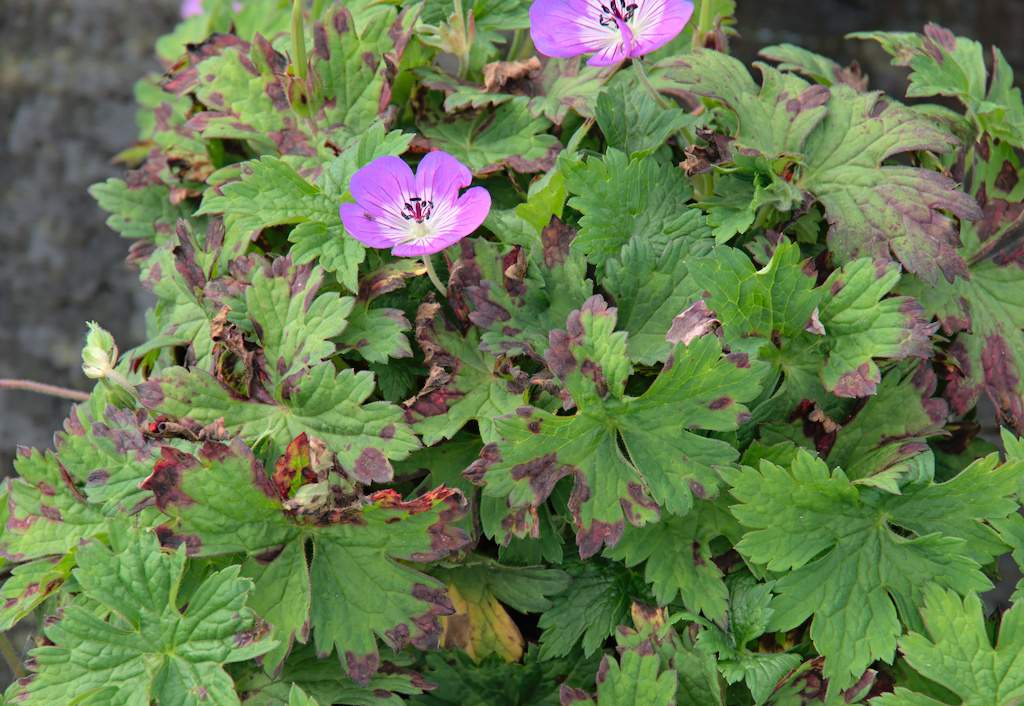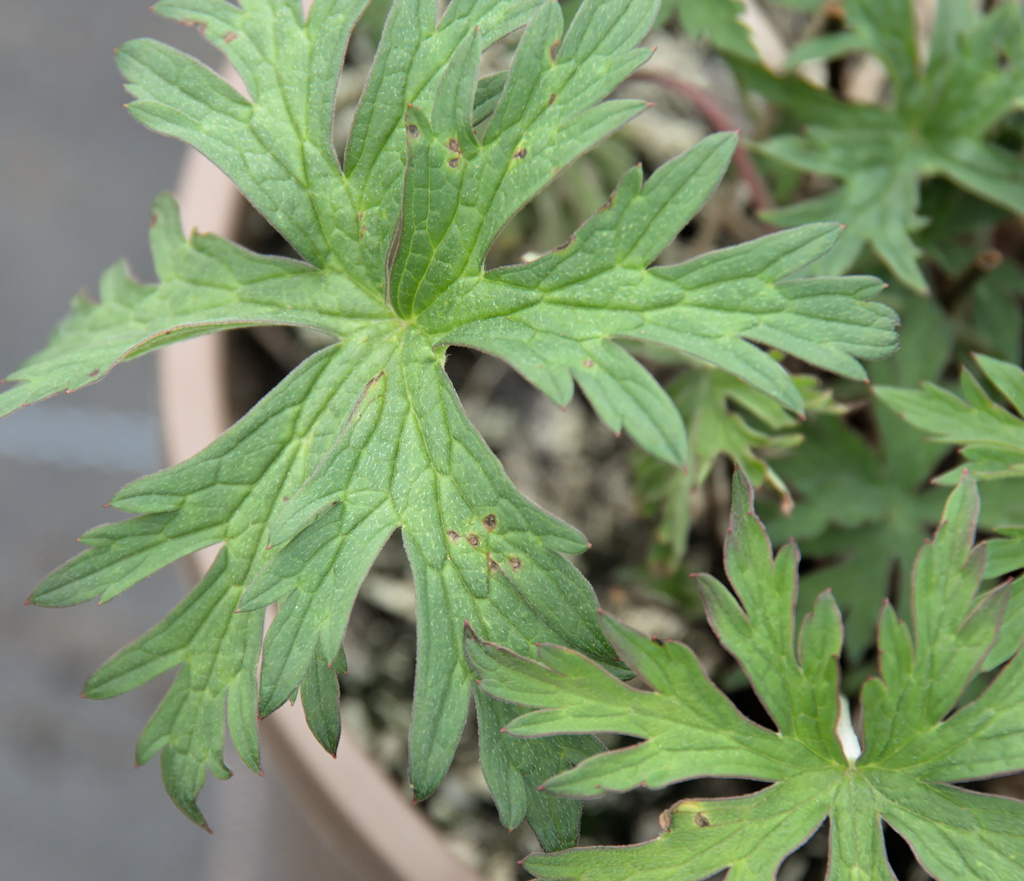Please click here to access the main AHDB website and other sectors.
- Home
- Knowledge library
- Bacterial leaf spot of hardy geranium: symptoms and biology
Bacterial leaf spot of hardy geranium: symptoms and biology
This page provides details of the symptoms and biology of bacterial leaf spot of hardy geraniums.
This information was last updated in 2023.
Go back to the main page: bacterial leaf spot of hardy geranium
Symptoms
The disease is usually seen as dark brown to almost black angular leaf spots. Spots are initially water-soaked and may have a greasy appearance. Depending on the host species or variety, spots are sometimes surrounded by a red or yellow halo. The pathogen also moves along the main veins causing larger necrotic areas, wilting or dry V-shaped sectors on the leaves.
Leaf nematodes can produce very similar leaf spot symptoms on hardy geraniums and are impossible to distinguish by eye. Find out more on the leaf and bud nematodes of hardy nursery stock page.
 S J Roberts
S J Roberts
Figure 1. Geranium renardii with bacterial leaf spot caused by Xanthomonas hortorum pv. pelargonii.
 S J Roberts
S J Roberts
Figure 2. Geranium maculatum with bacterial leaf spot caused by Xanthomonas hortorum pv. pelargonii.
 S J Roberts
S J Roberts
Figure 3. Geranium sylvaticum with bacterial leaf spot caused by Xanthomonas hortorum pv. pelargonii.
 S J Roberts
S J Roberts
Figure 4. Geranium with bacterial leaf spot caused by Xanthomonas hortorum pv. pelargonii.
 S J Roberts
S J Roberts
Figure 5. Inconspicuous early bacterial leaf spot symptoms on Geranium caused by Xanthomonas hortorum pv. pelargonii.
The pathogen
The disease is caused by the rod-shaped, motile, Gram-negative bacterium Xanthomonas hortorum pathovar (pv.) pelargonii (previously called Xanthomonas campestris pv. pelargonii or Xanthomonas pelargonii) (Xhp). This is the same pathogen that causes bacterial blight in tender pelargoniums. The host range is limited to Geranium spp. and Pelargonium spp.
Infection and disease development
The bacteria can live on plant surfaces and enter plant tissues through natural openings, such as stomata and hydathodes (pores at the edges of leaves), or via wounds. Thus, any events causing damage to plants, such as hail, frost, pruning, or other mechanical damage, may provide opportunities for infection.
Once inside the plant, bacteria multiply and symptoms develop when populations reach high levels. The speed at which symptoms become apparent depends on a range of factors, especially temperature, but is typically in the order of one to three weeks. A single visible leaf spot on a leaf may contain up to a billion bacteria, but even before symptoms become visible there may be as many as a million in a single leaf spot. These can be released rapidly once a leaf becomes wet. Thus symptomless plants can be highly infectious well before symptoms are apparent.
In tender pelargoniums the pathogen can systemically invade the vascular system, resulting in latent infections (without any symptoms), particularly at low temperatures. It is not known if this is the case in hardy geraniums. However, in plants infected in one year, symptoms will reappear on new growth in the spring after leaves have died down in the winter.
Epidemiology
Propagation
Most commercial varieties of hardy geraniums are propagated vegetatively by cuttings, division or micro-propagation (tissue culture). It is likely that such material is the primary source of inoculum and means of long-distance dissemination. Micro-propagated material is often wrongly assumed to be pathogen-free, but this is not necessarily the case.
Seed
By analogy with other diseases caused by Xanthomonas bacteria, seed transmission may be possible, but has not been reported or tested. There are suggestions that Xhp may be seed transmitted in pelargoniums.
Spread
Local (within-crop) spread occurs by water-splash, irrigation, or wind-driven rain, but anything that moves within and between crops (people, animals, insects, equipment, machinery) can potentially spread the bacterium, especially in wet conditions. It is important to be aware that considerable numbers of bacteria may be present and significant spread may have already occurred before any symptoms are seen.
We demonstrated the critical role of overhead water (from rain or irrigation) on bacterial leaf spot in an experiment to measure the rate of spread. In the plants grown outdoors with overhead irrigation, the pathogen effectively spread to all plants by the end of the experiment, whereas there was no spread at all in the plants grown under protection with sub-irrigation. For more details see the CP 191 project page.
We have also detected significant numbers of the pathogen in flowers of infected plants, so spread by pollinating insects is also likely.
Xanthomonas bacteria do not produce specialised resting spores, but vegetative cells can survive for long periods (at least several months) when protected in dry crop debris. Survival in moist, decaying crop debris or free in the soil is likely to be much shorter.
Useful links
Research project CP 174: Review of bacterial pathogens of economic importance to UK crops
Research project CP 191: looking at Improved Management of Bacterial Diseases in Horticultural Crops
Final report for research project HNS 91: Bacterial diseases of HNS: Chemical control
Read the reports: Project HNS 178 Bacterial diseases of herbaceous perennials
Author
Dr Steven J. Roberts, Plant Health Solutions Ltd., Warwick, UK.

